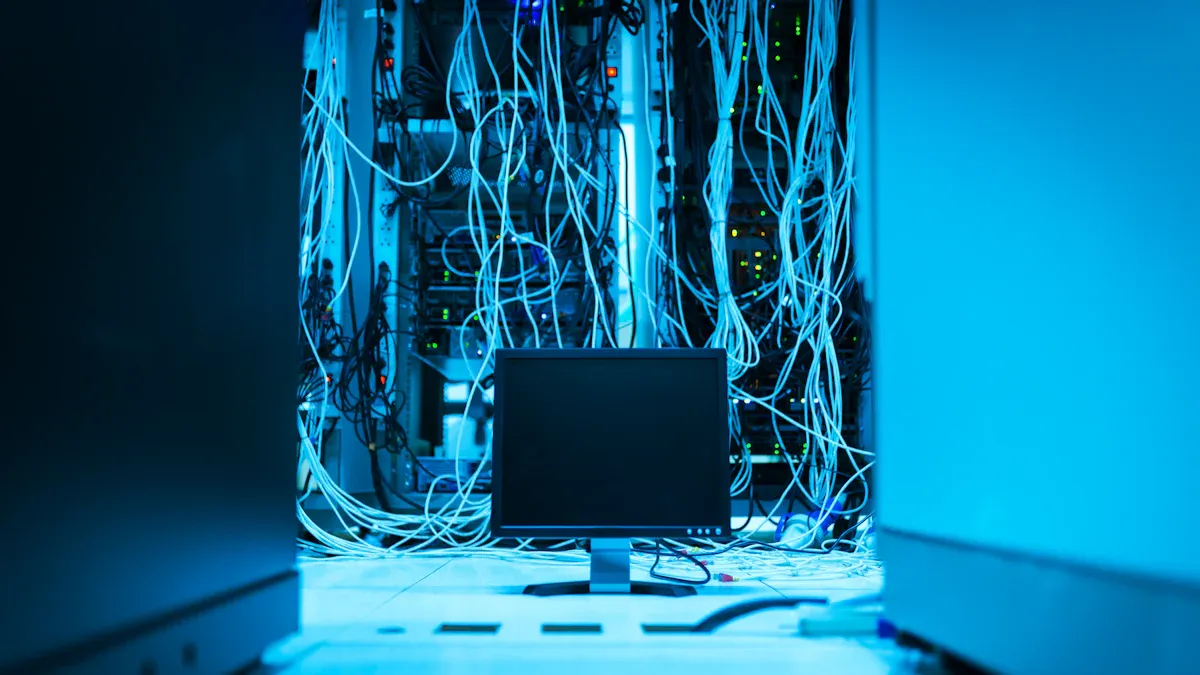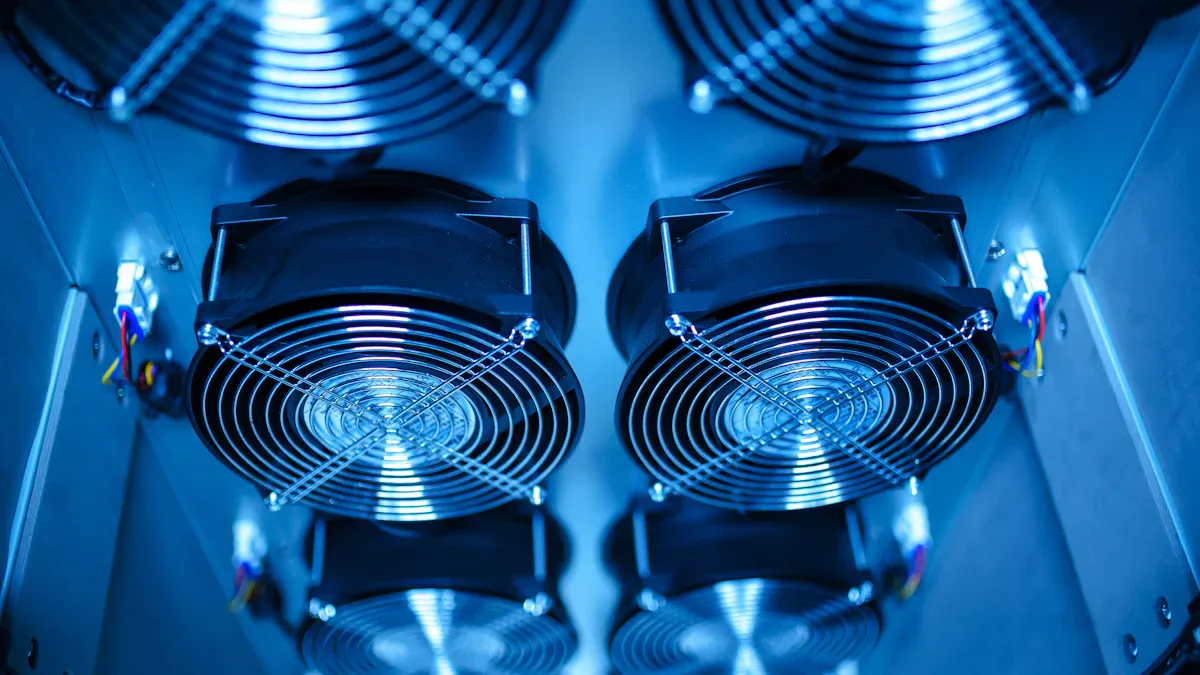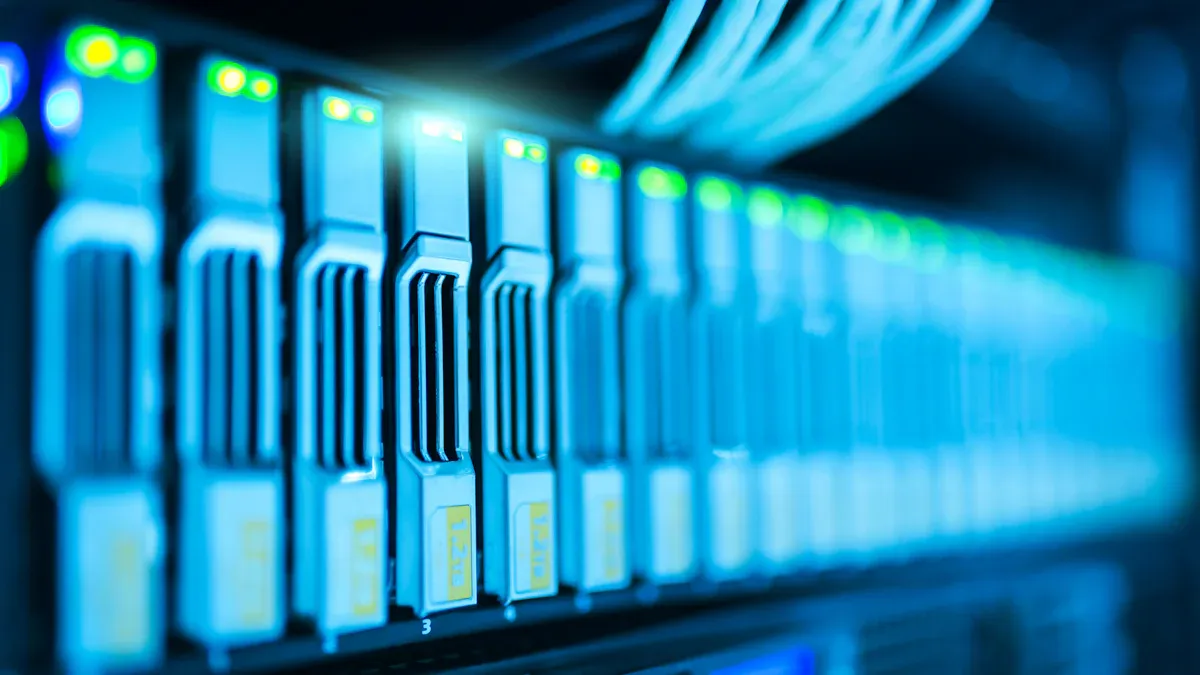How to Achieve Maximum Cooling Efficiency in Data Centers

Efficient server cooling is key to keeping data centers working well. Servers get very hot, and without proper cooling, they can overheat. Overheating can cause shutdowns or broken equipment. Cooling uses a lot of energy in data centers. For example:
Immersion cooling, a new method, can save 15,000 MWh of energy each year.
Using immersion cooling can save 3.5 million liters of water yearly. This helps save money and protect the environment.
Switching to better server cooling systems lowers energy use and helps the planet. Using new ideas like liquid cooling keeps servers cool, reliable, and affordable for the future.
Key Takeaways
Using liquid cooling saves energy and water. This helps data centers work better and be eco-friendly.
Smart airflow designs, like hot-aisle/cold-aisle setups, can boost cooling by 20-30%.
AI-powered cooling systems cut energy use by up to 40% and keep systems steady.
Checking and fixing cooling equipment often stops overheating and lowers repair costs.
Using renewable energy for cooling reduces pollution and helps the planet.
Understanding Cooling Challenges in Data Centers
Heat Generation and High-Density Server Cooling
Servers create a lot of heat while working. As technology improves, servers get smaller but more powerful. This makes them produce even more heat. Many servers in small spaces make cooling harder. Without good cooling, servers can overheat and stop working. Smart cooling systems help control heat better. They use live data to adjust cooling and keep servers running well.
Inefficiencies in Traditional Data Center Cooling Systems
Old cooling systems often waste energy. They cool the whole data center instead of focusing on hot spots. This leads to uneven cooling and higher energy use. New systems, like liquid cooling, fix these problems. They cool specific areas and save energy. Predictive maintenance helps avoid sudden breakdowns. It keeps cooling systems working properly.
Environmental and Energy Consumption Challenges
Data centers use a lot of energy. In the U.S., they take up about 3% of all energy. By 2030, this could be three times higher. High energy use harms the environment and stresses power systems. Green solutions are being created to help. These include reusing waste heat and using better technologies. Improving cooling can lower energy use and help the planet.
Advanced Technologies for Data Center Cooling

Liquid Cooling Systems for Better Efficiency
Liquid cooling is changing how data centers stay cool. These systems use liquids like water to take heat away from servers. Unlike air cooling, liquid cooling focuses on hot spots, making it very effective. It works well for powerful servers and AI tasks that create a lot of heat.
Reports show more data centers are using liquid cooling. This method improves how data centers work and uses less energy. As data centers grow, liquid cooling becomes more important. Air cooling often can't handle the heat, leading to higher costs. Liquid immersion cooling, a type of liquid cooling, dips servers in special liquids. This cools them better and reduces the need for extra tools like chillers.
Using liquid cooling helps control heat, saves energy, and protects equipment. It supports high-power servers and helps the environment by wasting less energy.
Airflow Optimization and Hot-Aisle/Cold-Aisle Setups
Good airflow is key to keeping servers cool. Bad airflow can cause some servers to overheat while others stay too cool. Organizing airflow ensures cool air reaches the right places.
One helpful setup is the hot-aisle/cold-aisle design. Server rows are arranged so cold air faces cold air, and hot air faces hot air. This stops hot and cold air from mixing, making cooling systems work better. Studies show this setup can improve cooling by 20–30%. Adding other airflow tricks can boost cooling by another 15–25%.
To get the best results, check and adjust your data center layout often. Using advanced cooling systems can also help keep temperatures steady across all servers.
Free Cooling and Economizers for Saving Energy
Free cooling uses natural air or water to cool servers. This reduces the need for machines like chillers. Some chillers can switch between free cooling and regular cooling based on the weather. This saves energy during cooler times while keeping servers at the right temperature.
Economizers are tools that bring in cool outside air to lower indoor temperatures. When used with free cooling, they reduce the work of cooling machines. This saves money and makes cooling equipment last longer.
Adding free cooling and economizers can save a lot of energy. These methods work best in cooler areas with natural cooling options. Using these ideas shows care for the planet and lowers costs.
AI-Driven Cooling Management Systems
AI cooling systems are changing how data centers stay cool. They use smart programs to watch and adjust cooling in real time. Sensors collect data, helping these systems use cooling resources wisely.
A big benefit of AI cooling is saving energy. These systems can lower energy use by up to 40%. They do this by matching fan and chiller work, avoiding waste. This automation saves energy and makes data centers work better.
AI cooling also keeps operations steady. It checks cooling needs and predicts future changes. This helps stop overheating and keeps servers working well. By reducing wear and tear, it makes cooling tools last longer and cuts repair costs.
Here’s a simple look at AI cooling benefits:
Feature | What It Does |
|---|---|
Energy Savings | Cuts energy use by up to 40%. |
Better Efficiency | Matches fan and chiller work to save energy. |
Stable Operations | Keeps data centers steady and reliable. |
Smart Predictions | Predicts cooling needs to avoid problems. |
Longer Equipment Life | Reduces wear, making tools last longer and need fewer repairs. |
Automation is key to AI cooling. It reacts fast to heat or workload changes. For example, if some servers get hotter, the system cools them right away. This keeps the data center running its best.
Using AI cooling saves energy and helps the planet. It lowers the carbon footprint while keeping systems reliable. As data centers grow, automation will be even more important for cooling efficiently.
Optimizing Energy Usage for Cooling Efficiency
Energy-Efficient Cooling Equipment and UPS Systems
Using energy-saving cooling tools helps data centers save power. High-efficiency chillers use less energy but still cool well. These systems focus on specific cooling needs, cutting waste and costs.
UPS systems are also important for saving energy. New UPS systems, like grid-friendly batteries, give backup power and ease grid pressure. For example:
Microsoft uses liquid immersion cooling to save energy.
Grid-interactive UPS batteries help Microsoft rely less on grid power, lowering carbon emissions.
Other smart tools, like Onics filters, also save energy. A 6 MW data center cut energy use by 9.2% with these filters. Another center saved 17.8% energy in lighting and support systems by improving power flow and reducing strain on transformers. These examples show how better cooling tools and UPS systems can save energy.
Tip: Check your cooling tools and UPS systems often. Make sure they meet energy-saving standards like Power Usage Effectiveness (PUE) and Carbon Usage Effectiveness (CUE).
Using Renewable Energy for Data Center Cooling
Renewable energy is a clean way to power cooling systems. Solar, wind, and water energy can run chillers and other cooling tools. Using renewable energy lowers carbon footprints and helps the planet.
Many data centers mix renewable energy with regular power. This ensures steady energy while using clean sources. For instance, solar panels can work during the day, and wind energy can help at night.
Renewable energy supports global green goals. It saves energy and shows care for the environment. This works well in places with lots of sunlight or strong winds.
Note: Do an energy check to find ways to add renewable energy to your cooling systems.
Lowering Cooling Needs with Server Consolidation
Server consolidation is a great way to save energy. Fewer servers mean less heat and lower cooling needs. This combines tasks onto fewer, stronger servers, cutting energy use.
Metrics like Power Usage Effectiveness (PUE) measure cooling efficiency. A lower PUE means better energy use. For example:
Metric | Description |
|---|---|
Power Usage Effectiveness (PUE) | Shows how energy-efficient a data center is. A PUE of 1.0 means all power is used for IT work, with no extra for cooling. |
Wells Fargo shows how server consolidation helps. Their efforts cut carbon emissions by 5.5% in 2012, 5.8% in 2013, and 5.2% in 2014. This proves consolidation saves energy and helps the environment.
Tip: Use virtualization to make servers work harder and need less cooling.
Best Practices for Server Cooling Maintenance
Real-Time Monitoring Systems for Proactive Management
Real-time monitoring helps keep cooling systems working well. Sensors check how equipment performs and track conditions around them. These systems use past and current data to spot problems early. For example, machine learning can warn about overheating or blocked airflow. Fixing these issues early stops downtime and saves money.
Some systems also improve water treatment. Automated tools add chemicals like inhibitors and biocides in the right amounts. This reduces waste and helps the environment. AI-powered cooling systems adjust settings to match cooling needs. This smart method can lower energy use by up to 40%, making data centers greener and more efficient.
Regular Maintenance of Cooling Equipment
Taking care of cooling tools regularly keeps them working their best. Skipping maintenance can cause higher energy bills and broken equipment. Check parts like fans, filters, and compressors often to ensure they work well. Cleaning filters and clearing airflow paths stops overheating.
Using refurbished equipment can make systems more reliable. Fixing and reusing old tools extends their life and avoids downtime. Selling extra or fixed items can even bring in extra money. These steps keep cooling systems efficient and reduce interruptions.
Predictive Analytics for Issue Prevention
Predictive analytics uses data to find future problems in cooling systems. Machine learning can predict hot spots in server racks. For example, better airflow can keep rack temperatures below 26.4°C at a 60% load. This prevents overheating and keeps servers running smoothly.
Wireless sensors show how equipment is doing in real time. They help catch wear and tear before it causes failures. Predictive maintenance focuses on fixing small issues early, saving repair costs. Using these tools keeps cooling systems efficient and makes equipment last longer.
Tip: Use predictive analytics with regular maintenance for better cooling. This plan improves reliability and saves energy.
Future-Proofing Data Center Cooling Systems

Building Cooling Systems That Can Grow and Change
To meet future needs, cooling systems must grow with data centers. Scalable systems handle more work without needing big changes. Adaptable systems let you add new tech easily. This keeps operations efficient and saves money.
Here’s what research says about scalable and adaptable cooling:
Source | Key Insights |
|---|---|
Revolutionizing Data Centers with Liquid Cooling | New liquid cooling tech boosts efficiency, lowers costs, and increases capacity. |
Liquid Cooling: Financial Insights | Shows cost benefits of direct chip and immersion cooling for upgrades or new setups. |
AI-Driven Cooling Panel Discussion | Explains how AI helps cooling systems handle heavy workloads and future AI needs. |
Designing scalable and adaptable systems saves money and improves efficiency. It also prepares your data center for future challenges.
Flexible Cooling with Modular Systems
Modular cooling systems are easy to adjust for your needs. These systems have pre-made units you can add or remove as needed. This reduces downtime and matches cooling to your workload.
For example, if your data center grows, just add more modules. You don’t need to replace the whole system. This saves money and lets you expand step by step. Maintenance is also simpler since you can fix one unit without stopping the whole system.
Getting Ready for New Cooling Tech
Staying ahead means using new cooling technologies. AI-powered liquid cooling is already changing the industry. The Global Energy Efficiency Initiative says AI with liquid cooling can cut energy use by 40%. This is great for centers handling AI and big data tasks. It supports green goals and saves energy.
To prepare, watch for new trends and invest in systems that can adapt. This keeps your data center efficient and ready for the future.
Getting the best cooling efficiency in data centers needs smart tools and ideas. Liquid cooling systems help save energy by cooling powerful servers and AI workloads. These systems work better, use less energy, and are great for today's data centers.
You can save energy and stay reliable by using scalable cooling systems, renewable energy, and improving airflow. Keeping equipment clean and using smart tools helps systems last longer. Start by checking your setup, adding new cooling systems, and watching how they work to prepare for the future.
Tip: Choose solutions that match your data center's growth and green goals for the best results.
FAQ
What is the best way to cool powerful servers?
Immersion cooling is great for powerful servers. It cools parts directly, saves energy, and works efficiently. This method also needs fewer extra cooling tools.
How can data centers spend less on cooling?
You can save money by improving airflow and using energy-saving tools. Free cooling methods and combining servers to make less heat also help.
Why is immersion cooling becoming more common?
Immersion cooling handles heat better for modern servers. It uses special liquids to cool parts directly, saving energy and making equipment last longer. It's perfect for AI tasks and crowded setups.
Can cooling systems run on renewable energy?
Yes, solar and wind power can run cooling systems. Mixing renewable energy with regular power keeps systems steady and helps the planet.
How does AI make cooling better?
AI watches and adjusts cooling as needed. It saves energy by matching cooling to server needs. It also stops overheating and keeps equipment from breaking.
See Also
Proven Strategies to Enhance Walk-In Chiller Performance
Steps to Create an Efficient Cold Storage Room
A Comprehensive Guide to Boosting ARKREF CO₂ Efficiency
Improving Chiller and Compressor Efficiency in ARKREF Units
Essential Advice for Effective Cold Room Temperature Management

